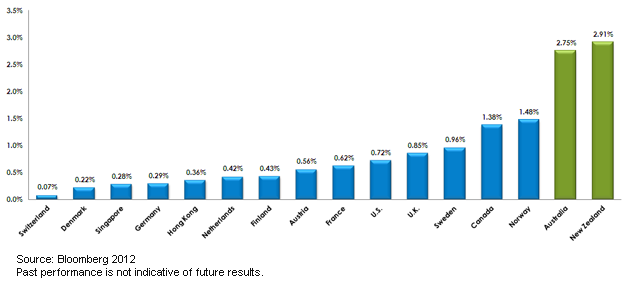A Currency ETF for the Long
Post on: 9 Апрель, 2015 No Comment

by Adam Nash on February 5, 2007
I caught a very interesting article in this weeks Business Week on a new Currency ETF that launched in September. The original article is here:
It doesnt look like theyve released the article to the free portion of the site yet, so let me summarize a bit here.
The new PowerShares DB G10 Currency Harvest Fund (Ticker: DBV ) has grown to about $180 Million already, allowing individual investors, for the first time, the ability to easily invest in the long-short trade. The long-short trade is when you buy the currencies of countries with high interest rates, and you sell short the currencies of countries with low interest rates. Normally, countries with higher rates see their currencies appreciate relative to those with low rates, and this strategy lets you capture the difference. You can think of it as borrowing cheap money (the short against the countries with low rates) to buy investments that pay higher rates (the countries with higher rates).
For example, right now New Zealand is paying interest rates of 7.6%, and Japan is paying just 0.5%.
This trade is a common one, but its not without its problems. There have been many times, historically, when large hedge funds used leverage to play this game, only to have the market move against them. Usually, however, the implosion involved big bets in emerging markets.
This fund only invests in the currencies of developed nations with high credit ratings, and employs only 2:1 leverage, so its relatively safe.
Here are the current holdings of the fund:
Long Positions:
- Australian Dollar
- New Zealand Dollar
- US Dollar
Short Positions:
- Japanese Yen
- Swedish Krona
- Swiss Franc
The fund is based on the new Deutsche Bank G10 Currency Future Harvest Index, which has been backtested to produce a 11.4% annualized return over the last 10 years. That being said, its a new index, and how it will behave in real life may vary.
What is interesting about the index, however, is that it has returned 3.2% more than the S&P 500 over the same time period, but with only half the volatility. Not only that, the carry trade has very little correlation with stocks, so its a natural for diversification.
Previous Currency ETFs, launched by Rydex. have allowed investors to buy into individual currencies:
- Euro (Ticker: FXE )
- Mexican Peso (Ticker: FXM )
- Swedish Krona (Ticker: FXS )
- Australian Dollar (Ticker: FXA )
- British Pound (Ticker: FXB )
- Canadian Dollar (Ticker: FXC )
- Swiss Franc (Ticker: FXF )
Unfortunately, the structure of these ETFs has built in high fees and spreads, making them poor ways to try and own that currency .
If you are interested in the new new PowerShares DB G10 Currency Harvest Fund, be aware that the strategy does have some limitations. As covered in TheStreet.com:
Im convinced that the strategy has merit, but as with all strategies, there are flaws that should be understood before purchasing.
Higher yields do tend to make a currency more attractive, but that overlooks an important point: Currencies whose interest rates are moving up tend to be strong. A currency starting from a low base interest rate that is headed higher is likely to be a strong currency, but it could be overlooked by the ETFs strategy.
However, if you are looking for a currency component to your asset allocation, this fund is definitely worth considering. There are some tax considerations as well, because the fund uses futures to do its trading. As a result, it might be best to hold this in a tax-advantaged account, like an IRA.














